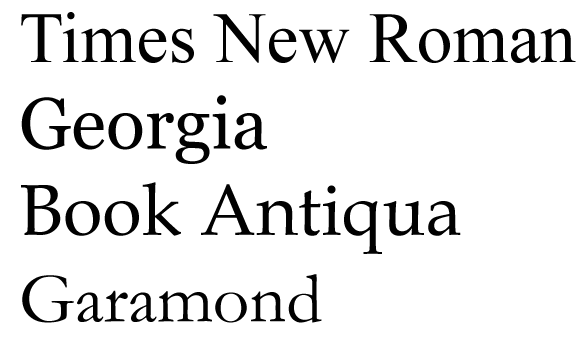

Georgia is visually larger than Times New Roman.
#Roman font trminal serif how to
As a web typographer, you should know how to look at and think about the parts of letters so you can identify other legible fonts to use (not just Georgia and Verdana). The number of fonts available to web typographers has exploded. I use Georgia and Verdana in examples and lessons throughout TWD, but they aren’t the only acceptable fonts. Designed for the screen, they are easy to read. Georgia and Verdana are superior fonts for legibility of text on the web. All four are web-safe fonts and likely to be on most computers, regardless of platform. Next I’ll compare Georgia to Times New Roman, and Verdana to Arial. That might seem odd, but Helvetica is famous for its simplicity and clarity, which makes it the perfect example to show that clean and simple aren’t enough to guarantee legibility onscreen.

Comparing Web Safe FontsĪbove I compared the web-safe font Georgia with Helvetica, which isn’t web-safe. Bottom: Helvetica’s e and a look similar, and the e closes up into a circle at text sizes.

Top: Georgia’s larger aperture help with legibility. Serifs are little horizontal strokes, usually coming off the top and/or bottom of a stem, which is a vertical stroke in a letter.ġ0 aperture 11 terminal. Note the descenders in Georgia and Helvetica are almost the same length, but Georgia’s serifs give the descenders more presence. The baseline is an invisible line that the letters appear to sit on. Typographic Termsĭescenders are the strokes of the letters that extend below the baseline. It also has open apertures, discernible terminals, and slightly looser letter spacing than Helvetica. In typographical terms, it has a healthy x-height without sacrificing the ascenders and descenders. Georgia, by type designer Matthew Carter, was designed for the screen. Words and letters are more clear, allowing the eye to move quickly along the line of text. Bottom: Georgia 14/20 on a 1280×800 MacBook Air screen is a bit easier to read. Letters feel tight, and the letter e closes up into a circle. Top: Helvetica 14/20 on a 1280×800 MacBook Air screen. But text set in Georgia is a bit easier to read, even though it looks slightly smaller than Helvetica and is a more complex font. Helvetica is simpler and cleaner than Georgia. That’s a good rule of thumb, but it’s not quite enough. You’ll often hear “simple” fonts are better for the screen because of resolution issues. Thin strokes and small spaces in letterforms can start to disappear, and as in the photocopy example, the text gets harder to read. Web typographers need to pay particular attention to the strokes and spaces in a font because of screen resolution. Thinner strokes start to disappear, leaving only parts of the letters.Įither way, when strokes or spaces get lost, the legibility of the font changes, and reading becomes more difficult. The spaces in and around the letters start to disappear. Why does this happen? Sometimes, the strokes in the text thicker. If we lose either of these elements, legibility is compromised.ĭid you ever try to read a poor photocopy of a photocopy of a photocopy? Experience tells you that type becomes harder to read with each generation of copying. These shapes are created primarily by two elements: the strokes of the letters and the spaces in and around the letters. When we read, we don’t see individual letters we see (and read) the shapes of the words. One factor that affects readability, and a great place to start, is choosing a legible font. If text feels hard to read, people won’t want to read it.


 0 kommentar(er)
0 kommentar(er)
